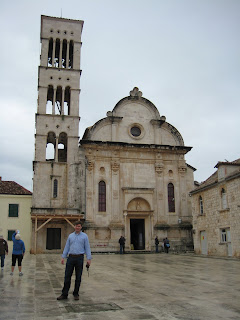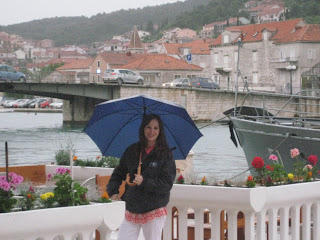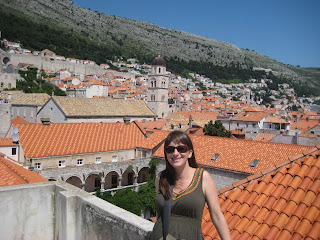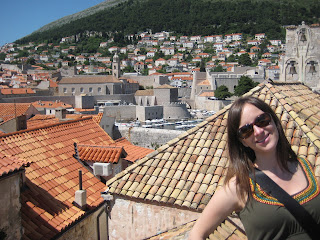SPLIT
We had a complimentary upgrade to the hotel Le Meridian through our travel agency.
Beautiful views from our hotel balcony (yacht parking lot), beach, and poolside. The beaches along the Adriatic Coast are rocky, not sandy.
Venetian architectural influence in Split
Opera house (left) and theatre (right) - 2nd world countries continue to cultivate refined tastes
Diocletian's Palace - in 295AD, the Roman emperor decided to retire in Split and ordered his magnificant palace be built in 10 years. It is a UNESCO protected site albeit people living within the walls.
HVAR
Hvar is known for having the sunniest hours in a day of all the Adriatic Islands...unfortunately, we cannot attest to this. Hvar was an important sea route during ancient times for the Venetians.
 Hvar was the first place to allow the commoners to view theatre (building to the right of the church) at the same time the elite did. This was a meeting ground in the town square since it separated the elite living grounds from the commoners'.
Hvar was the first place to allow the commoners to view theatre (building to the right of the church) at the same time the elite did. This was a meeting ground in the town square since it separated the elite living grounds from the commoners'. The "dry wall" pictured behind us is made of stacked rocks to divide the native's plot of land for agriculture. Hvar is known for its lavendar fields and olive trees, although it isn't cultivated as much anymore.
The "dry wall" pictured behind us is made of stacked rocks to divide the native's plot of land for agriculture. Hvar is known for its lavendar fields and olive trees, although it isn't cultivated as much anymore.
We made the most of our overcast/rainy day and took a tour around the island. The tour group made a special call to the mayor to open up the fortress viewing grounds for us :)
Jon kissing this fresh caught fish good-bye. We had amberjack for dinner at Gariful Restaurant.
PLITIVICE LAKES NATIONAL PARK (UNESCO protected since 1979)
We took a day trip to the inland for the mountain lakes that provide a unique oasis of natural beauty. The park consists of 16 connecting lakes with cascades of waterfalls. The emerald water is crystal clear and populated with fish.
We were surprised how close the trail takes you to the waterfalls. Breath-taking views along our hike when we weren't standing over or right next to the waterfalls. The grand finale on the right.
TROGIR
We stopped at this museum town on our way home from the lakes tour. This is considered the oldest city in Croatia, dating more than 2000 years old. The old town island has one of the highest church densities in the world and beautiful buildings in the Romanesque, Renaissance, and Baroque architectural style.
Coastal Road from Split to DubrovnikThe longer but far more scenic view was a higlight of our trip. Seeing how the towns are built in similar fashion and spotted along the coast gave us a true sense of Croatia outside of the city centers.
Croatians rave about their Dignac and Postup reds made from the Plavac Mali grape. Pope Benedict order 30 bottles of the Dignac Reserve we tasted at a local vineyard.


 KORCULAOur relaxing ferry ride and quick visit to this island known for the legendary explorer Marco Polo's home.
KORCULAOur relaxing ferry ride and quick visit to this island known for the legendary explorer Marco Polo's home.MONTENEGRO (black mountain)
We took a full day trip, guided tour to a neighboring country to see the contrast against Croatia. Montenegro recently became its own country, departing from Serbia in 2006. While Croatia is on the kuna currency, Montenegro has been tied to Germany's central bank in Euros. Croatia has a much higher annual average income of $10-12K compared to Montenegro of $4,800 - $5,400. The Montenegrans still use cyrillic letters on many of their signs because of their close ties to Russia (where you didn't see this at all throughout Croatia). An estimated 50% of Montenegro's property is owned by Russians.
PERAST/BAY OF KOTOR (first stop)
Sometimes called Europe's southernmost fjord is in fact a ria - a coastal inlet formed by the partial submergence of an unglaciated river valley (a drowned river valley that remains open to the sea).
Our Lady of the Rock is a man-made island built for a church, now converted into a museum. Some fishermen found this random painting of Mary (below) on a rock in that exact location in 1452AD. Since then, many sailors believe she has saved them from storms, illnesses and many sea-faring scares (praying to her and bringing items of dedication).
KOTOR (2nd stop)
The old city is a well preserved urbanization typical of the middle Ages, built between the 12th and 14th century.


The moat used to surround the entire old city of Kotor, the site is UNESCO proected.
BUDVA (3rd stop)
I was astounded by the amount of graffitti all over Montenegro and Croatia. If only they could clean up the distracting art/messages to better preserve the historic monuments. The kids around Budva were celebrating their last day of school so it was fun to witness their song and dance. The water was cool but it didn't stop me from dipping my toes into the Adriatic; refreshing on a warm day.
DUBROVNIKThis classic medieval heartstopper is filled with ancient fairy tales. We were reminded of the historical events that brought together the population living in this old city, dating back to the 7th century. For instance, the Jewish population retreated here (from Portugal and Spain mainly), as the town needed bankers (it was illegal for Catholics to charge interest). They also proved to be "better" doctors for the time since Jews were able to conduct autopsies whereas the Catholics were not.
Croatians would only admit to being ruled by the Greeks, Romans, Ottoman Austrian empire, and the French (Napoleon had his fortress overlooking Dubrovnik that is today a museum). The French ruling of Dubrovnik was interesting - they chose the French over the Russians, as they both waited in anticipation to take over the city.

We stopped in for an afternoon break after our walking tour and before we began our journey around the old city walls (aerial views below). This bar was literally cut out of the walls, previously protecting Dubrovnik, and provided us with breath-taking views of the surrounding islands and water.




































































